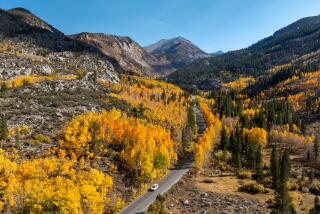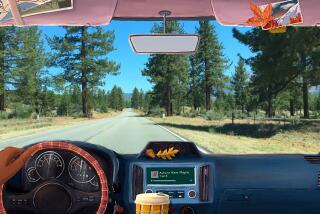In Blue Ridge Mountains, autumn hues are wedded with history
Reporting from the Blue Ridge Parkway, Va. — When the Blue Ridge Parkway beckons me, I answer, especially in autumn, when I long for its twists and turns, its waterfalls, natural gardens, forests and upland meadows that dot its nearly 500 miles in Virginia and North Carolina.
Little has changed here in the 75 years since the parkway construction began, permanently linking Virginia’s Shenandoah National Park in the north and the Great Smoky Mountains National Park in the south. It took 52 years and hundreds of workers to complete this public works project, which helped Appalachia climb out of the Great Depression.
Thanks to varying elevations, a drive in October and even into early November will yield good views of fall hues. Hickory, tulip poplar and ash are ablaze with yellows, and reds burst forth from dogwood, maple, sumac and sourwood trees. This year mountain ash trees at higher elevations have an outstanding crop of bright red berries. To hear a fall color report, call (828) 298-0398 and punch 7.
It may tell you about the leaves, but it won’t tell you about the loaves — of homemade bread. And apple and pumpkin butter. And mountain honey and homemade pies. Wayside gourmets will find a bounty in mountain cafes and fresh market stands in tiny mountain communities just off the roadway. Add an order of fried chicken, a picnic blanket and a scenic overlook, and you’ve got yourself a respite unlike any other I’ve experienced.
I’ve spent a lot of time in the area. My family used to pile in the car for fall color drives along the parkway, and I even went to summer camp here. In fact, I met a boy here when I was 13, and even though our families made the annual pilgrimage to see the change of seasons, our paths didn’t cross again until we were well into our 30s. In fact, 27 years to the day we met, we married.
But ours is not a singular romance; others have a fondness for this region, which attracts visitors from all over the world. Margaret and John Sidaway, for instance, recently traveled from their home in West Midlands, England, to vacation along the Blue Ridge Parkway. They flew 4,000 miles and drove 200 more.
“We did not stop at every highlighted spot as it would have taken us forever, but enough to take in the overlooks and view the wonderful scenery,” Margaret Sidaway said. They stopped in Roanoke, Va., which has a thriving downtown historic district and some find dining.
That’s part of the joy of the parkway. You can stop hither and yon, at church picnics or community festivals. You won’t find these on the Internet; you may find them advertised in the local barber shop. My advice is to take a plan with you, but go without an agenda because you never know when you might stumble on an antique car shows or a mountain auction.
The Sidaways got a satisfying taste of Appalachian culture at historic Mabry Mill, one of the most photographed stops on the parkway, and Humpback Rocks. Mabry Mill, about a 90-minute drive south from Roanoke, is a step back in history to a time of gristmills, sawmills, woodworking and blacksmith shops. National Park Service employees and volunteers demonstrate skills as diverse as basket weaving, seat caning, spinning and weaving. A Sunday stop at Mabry Mill during the color season affords a special mountain treat: the making (and tasting) of homemade apple butter and the playing of old-time music. (Weather may affect activities; seear https://www.blueridgepkway75.org for details.)
The massive rock formation known as Humpback Rocks near Waynesboro, Va., served as a landmark for wagon trains traversing Virginia’s Howardsville Turnpike, used to transport goods across the Blue Ridge Mountains during the 1840s. A single-room log cabin and outbuildings at the Humpback Rocks visitor center (at Mile 5.8) represent 19th century life. From late May through October, costumed role players show visitors how weaving, basket making, gardening and other tasks occupied the lives of settlers.
“We found it very interesting to think of the hard life they must have endured, carrying water up and down a steep slope compared with today’s running water,” Margaret Sidaway said.
But, oh, what a backdrop.
To learn more, go to https://www.blueridgeparkway.org or https://www.nps.gov/blri.
More to Read
Sign up for The Wild
We’ll help you find the best places to hike, bike and run, as well as the perfect silent spots for meditation and yoga.
You may occasionally receive promotional content from the Los Angeles Times.






